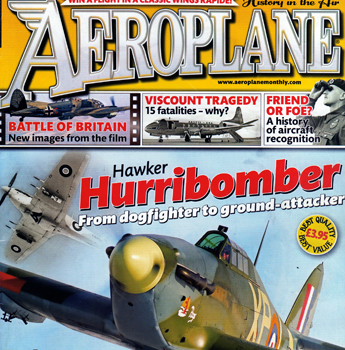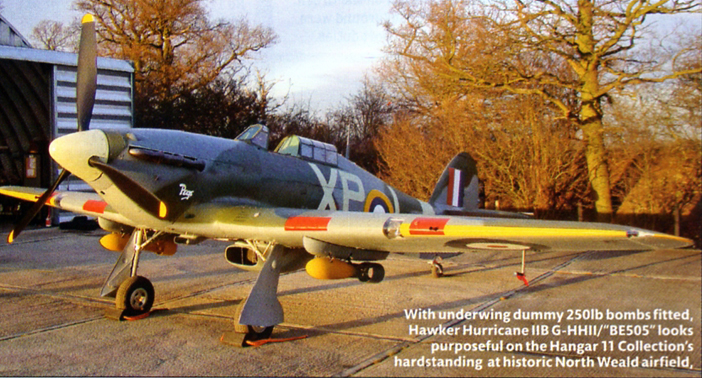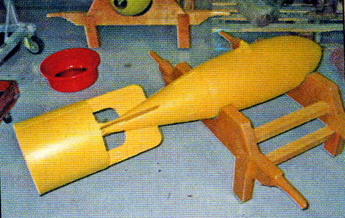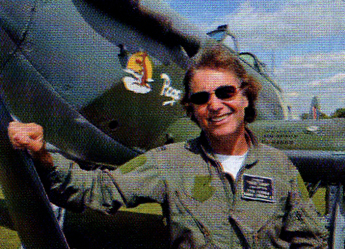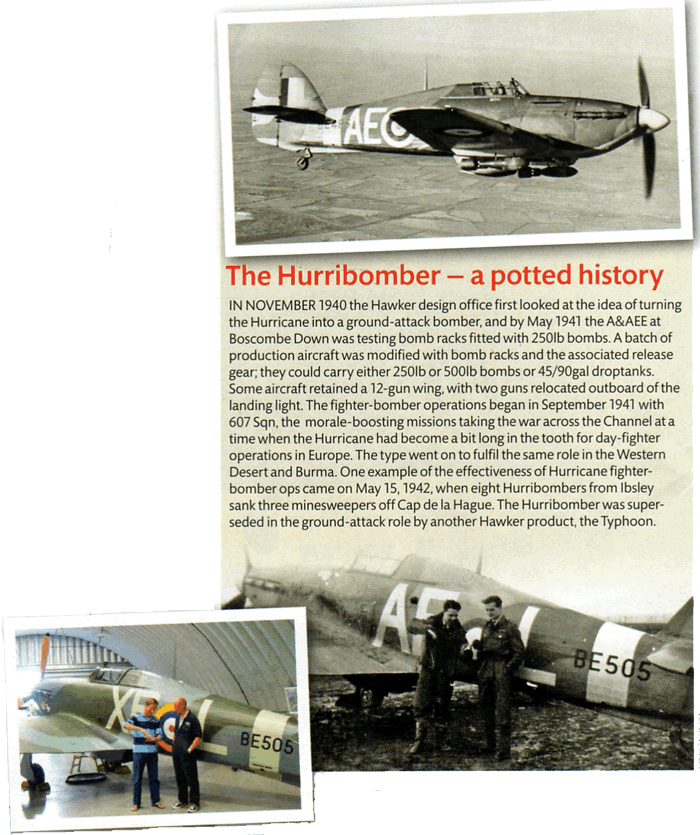AS MOMENTS OF quintessential Englishness go, this was going to take some bearing. A glorious August morning at the former Battle of Britain airfield at North Weald, and the hangar doors are rolled open to reveal a newly-restored Hawker Hurricane IIB, its broad-shouldered, four-square Churchillian countenance accentuated on this occasion by the 250lb bombs under each wing.
As the doors settle into their stays, a transistor radio in the hangar goes off the deep end as England fast bowler Graham Onions takes consecutive Australian wickets with the first two balls o the morning’s play in the third Ashes test. Only the previous week England had beaten the old enemy at Lords cricket ground for the first time in 75 years, and now, after a timespan only ten years shorter than that, a Hawker Hurribomber is about to be seen flying in public again |
The owner of the aeroplane, Peter Teichman, emerges from the hangar. “You’ll not have seen one life this before”, he smiles. “It has a lot of presence, don’t you think? We can’t fly it with the bombs attached yet, but we are talking to the Civil Aviation Authority about that for next display season.”
Once the aircraft has been rolled outside, Peter’s engineer begins to remove the very convincing replica bombs – for, today, Peter will fly a display in the Hurricane for only the second time, at a corporate event at Bearstead down in the Weald of Kent, where Hurricanes gained immortality in the dark, decisive days of the Battle of Britain.
After displaying the Hurricane, Peter will return to ‘Weald and strap into his Supermarine Spitfire PR.XI, to fly back for a second display. He is now the busiest civilian warbird pilot in Europe, flying 60 public flying displays last season in his Hangar 11 Collection fleet of Curtiss P-40 Kittyhawk, North American P-51D and photo reconnaissance Spitfire.
Peter enthuses, “I want as many people as possible to see these aeroplanes”. Before the test series is over in late August, Peter is due to fly 16 displays over a two-week period, and the Hurricane will be an established fixture on the UK airshow circuit. “The ethos of the Hangar 11 Collection”, he continues, “is to have four of the greatest RAF fighters flying from North Weald, a historic RAF base. Hurricanes flew from here with No 11 Group’s 249 Sqn in the Battle of Britain, so it would be inconceivable not to have a Hurricane – an example of the aircraft that saved the nation more than any other.”
Finding a candidate
Compared with preserved Spitfires, “there is a lot less choice” when acquiring a Hurricane, says Peter. “I Looked at one overseas but soon realised I wanted one from Hawker Restorations Ltd (HRL). They are not just aircraft restorers, but the world’s finest Hurricane restorers.”
The aircraft was previously owned by HRL’s Tony Ditheridge, who was rebuilding it as his personal project. “The work was a year and a half along,” says Peter, “an all the key parts were in place when I acquired it. I signed a rebuild contract with Tony in 2006.”
Built in Canada in 1942 as CCF/R20023, it is one of 1,451 Hurricanes made under licence by Canadian Car & Foundry. Early examples were completed as Mk IIBs with wing attachment points for bomb racks or droptanks, while later ones were built as Mk XIIs. It served with the RCAF as a home-based fighter for the duration of the war. In 1946 it was refurbished to as-new condition and then disposed of as surplus, engine up on a Canadian farm.
Tony Ditheridge bought the Hurricane from Bob Schneider in Hawkins, Texas, in 1989. The package included fuselage, engine mount, tailplane and wings.
“During the restoration I went over to the HRL workshop every couple of weeks”, says Peter. “It was very important to get to know the aircraft from the ground up, and to understand the construction philosophy. It was great to feel part of it.” Retaining originality was also a key requirement. “Anything that could be reused went back on the aeroplane; other missing parts were replaced by original period items wherever possible, as in most cases new parts are just not available”.
Tony Ditheridge, who founded HRL in 1994, relished the chance to restore the aircraft as a Hurribomer. “The first Hurricane we rebuilt took us 34,000 man-hours, but we are now down to about 26,000hr. The challenge on this one was sourcing original bomb rack parts and all the drawings. The bomb racks are very complex, although externally they look simple. In addition this aircraft had 12 guns, not eight, and we had never done a 12-gun Hurricane. Also a huge amount of research went into the exact fabric, paint and stencils.” |
